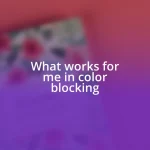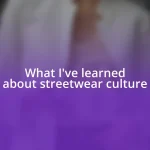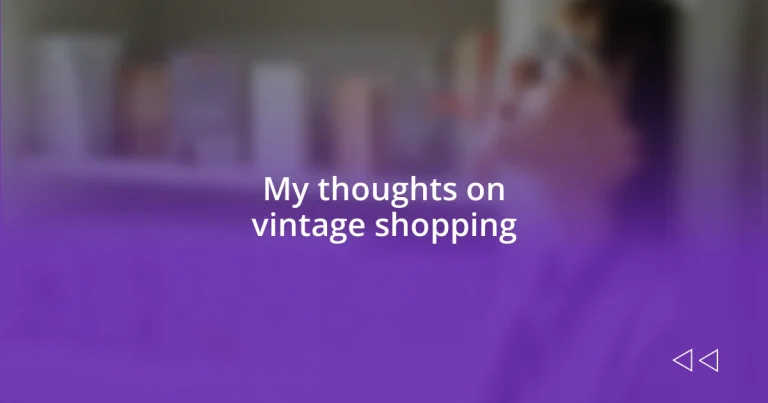Key takeaways:
- Vintage shopping offers uniqueness, sustainability, and a sense of community, enhancing personal style while supporting eco-friendly practices.
- Successful vintage finds require patience, careful inspection, and exploration of various locations, including thrift stores and flea markets.
- Caring for vintage items is essential; proper washing, storage, and regular inspections help maintain their quality and longevity.
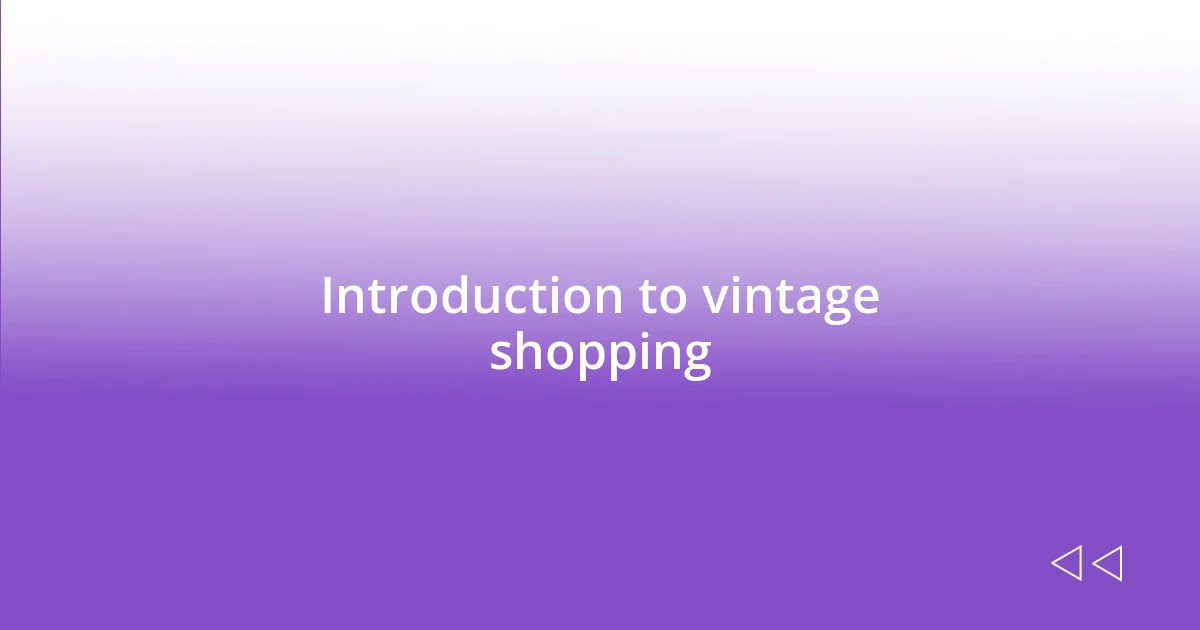
Introduction to vintage shopping
Vintage shopping is more than just a trend; it’s a delightful journey through time. I remember the first time I stumbled upon a quaint thrift store tucked away on a side street. As I sifted through racks of unique clothing, each piece seemed to tell its own story, igniting my curiosity about the lives it once touched.
There’s something incredibly thrilling about unearthing hidden gems with a history. Have you ever tried on a dress that instantly transported you to a different era? I’ve had moments where slipping into a vintage piece felt like stepping into the shoes of a bygone fashionista, igniting my imagination and spirit.
Understanding vintage shopping also means navigating its nuances—like distinguishing genuine vintage from mere retro-inspired styles. From the craftsmanship of past decades to the sustainability benefits of choosing second-hand items, the experience enriches our wardrobes and our lives. So, what draws you to vintage shopping? Is it the thrill of the hunt or the love for unique fashion? I believe it’s a bit of both, and that’s what makes it so rewarding.
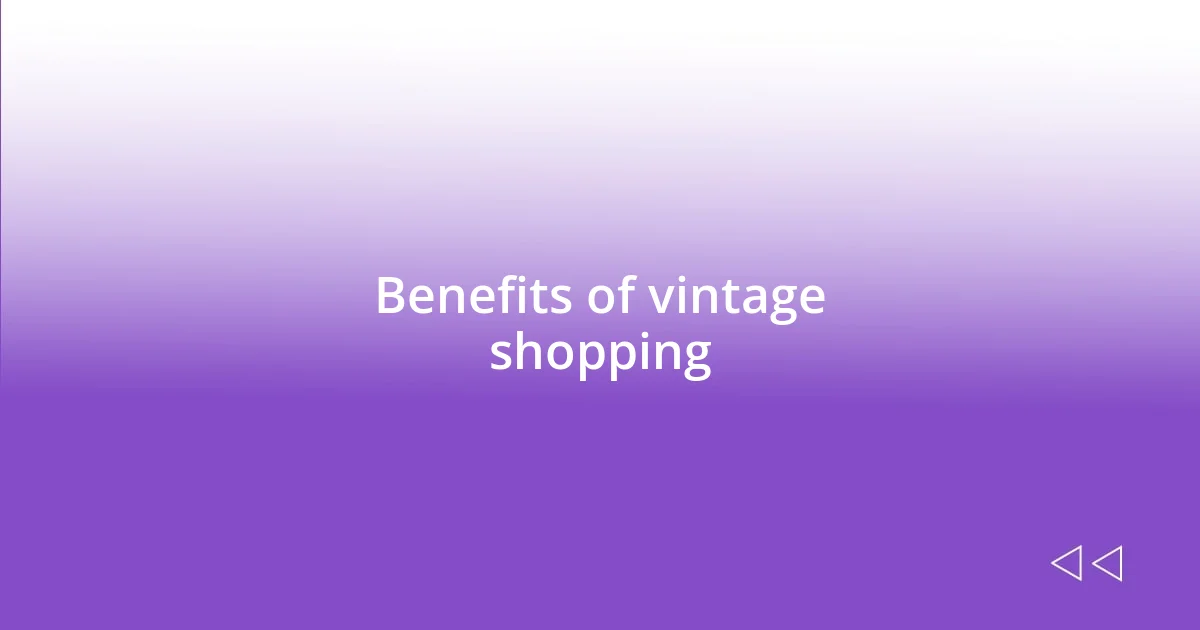
Benefits of vintage shopping
One of the most compelling benefits of vintage shopping is the uniqueness it brings to my wardrobe. I vividly recall one time when I found a colorful 70s floral dress that made me feel like a walking piece of art. Unlike mass-produced fast fashion, wearing vintage means showcasing pieces that not everyone will own, allowing for a truly individual expression of style. It gives me a sense of confidence and a connection to the creative spirit of those who wore these items before me.
Another significant advantage lies in the joy of sustainable fashion. I often reflect on my choice to shop vintage instead of contributing to the cycle of new clothing that often harms the environment. Each vintage piece I buy feels like a small victory against fast fashion waste, which is something I take great pride in. It’s comforting to know that I’m supporting a more eco-friendly approach while building a wardrobe full of history and character.
Finally, vintage shopping often becomes a social adventure, whether I’m exploring flea markets with friends or sharing stories with fellow enthusiasts. I cherish the friendly conversations that often spring up with shop owners or other shoppers who share a passion for the past. These moments not only enhance my experience but also create a sense of community around our shared love for vintage treasures. Instead of shopping being a solitary task, it becomes a vibrant interaction filled with stories and connections.
| Benefit | Description |
|---|---|
| Uniqueness | Vintage pieces allow for personal expression and stand out from mass-produced items. |
| Sustainability | Shopping vintage supports eco-friendly practices by reducing waste and promoting recycling. |
| Community | Vintage shopping fosters social interactions and connections among enthusiasts. |

Tips for successful vintage finds
Finding a true vintage treasure can sometimes feel like an exhilarating game of hide-and-seek. I’ve learned that patience is key; rushing through a store often means missing out on something spectacular. I recall a sunny Saturday spent in a bustling flea market, where it took me hours to sift through countless racks. Yet, that day ended in triumph when I unearthed a stunning 1940s silk blouse, its intricate patterns whispering tales of the past.
Here are some practical tips to increase your chances of making successful vintage finds:
- Know your measurements: Sizes vary wildly across decades, so it helps to carry a tape measure or know your specific measurements to ensure a good fit.
- Inspect items carefully: Look for signs of wear and tear, such as holes, stains, or missing buttons. A little damage can often be repaired, but you want to be aware of what you’re committing to.
- Explore different places: Don’t just stick to the trendy boutiques; hit up thrift stores, yard sales, and flea markets. New treasures can often be found in unexpected places.
- Follow your instincts: If something catches your eye, even if it’s not what you typically wear, give it a try. Vintage pieces can sometimes surprise you with their charm when you least expect it.
- Be patient and persistent: The best finds often require a repeated effort. Don’t be discouraged by what you don’t find on your first visit; make it a habit to return to your favorite spots regularly.
Just remember, the thrill lies not only in the finds themselves but also in the adventure of searching. Each trip can be a story waiting to unfold, and who knows what you might discover next?
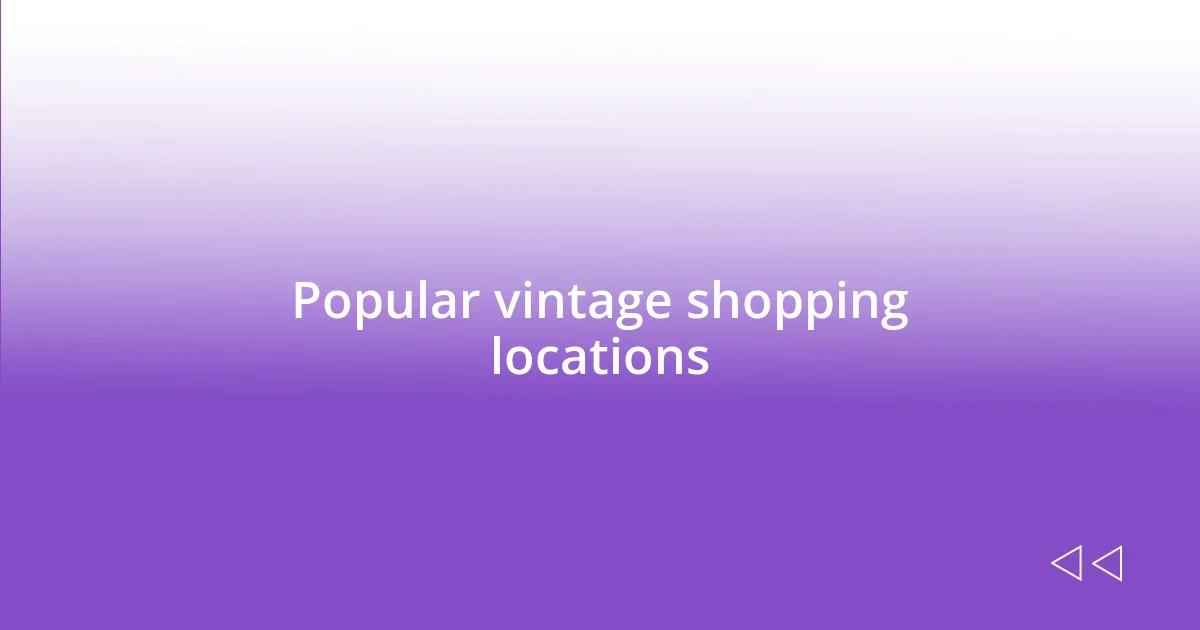
Popular vintage shopping locations
When I think about popular vintage shopping locations, a few places instantly come to mind. One of my favorites is the eclectic charm of Portobello Market in London. Wandering through its vibrant stalls, I remember the thrill of discovering unique vinyl records and a beautiful pair of high-waisted jeans that fit me perfectly. It’s a treasure trove of history, and every corner has a story waiting to be uncovered.
In the heart of New York City, the East Village boasts a collection of vintage shops that are simply irresistible. I often find myself drawn to a quaint little store tucked away on a side street. One day, I stumbled upon a chic 1950s hat that instantly transformed my outfit. Imagine how that small piece added such a dramatic flair! It’s mesmerizing to think about the fashionable lives these items once led. Have you ever wondered about the people who wore these pieces before us?
Then there’s my experience at thrift stores like Goodwill or Salvation Army, which often yield surprising gems. On a recent visit, I found a stunning 80s designer blazer that became my go-to for special occasions. These places may not have the same ambiance as boutiques, but they hold the potential for the most unexpected finds. The unpredictability of each visit makes the hunt even more exciting—what will you discover next? The answer lies in the adventure awaiting you.
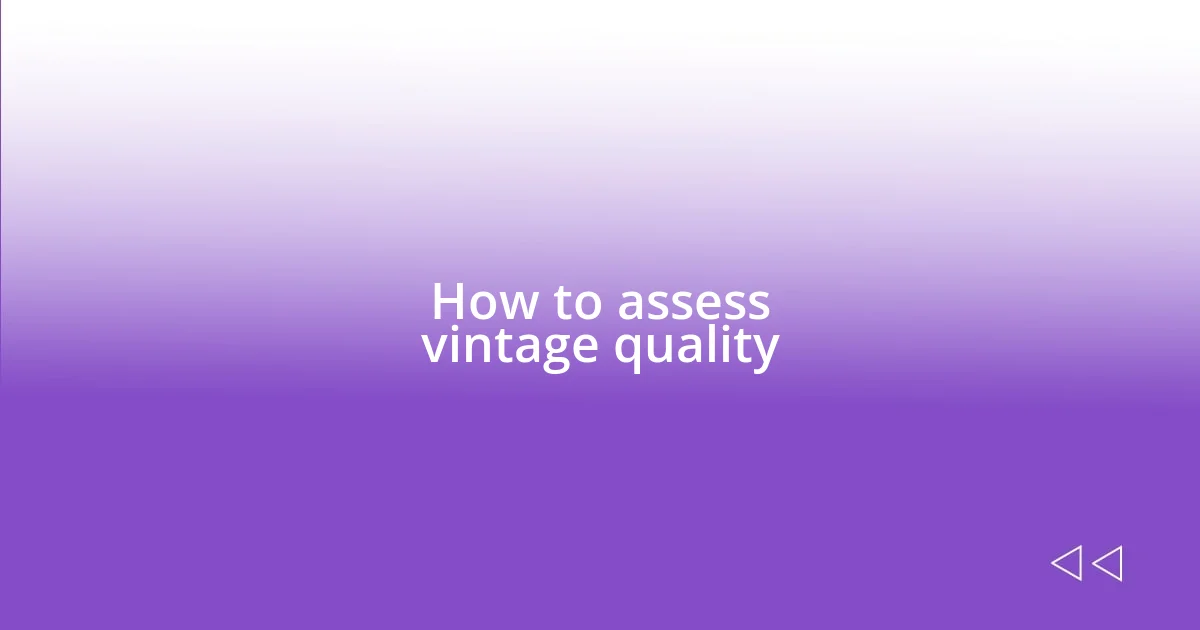
How to assess vintage quality
To assess vintage quality, I always start with a thorough inspection. One memorable vintage piece I bought had a delicate hemline that initially caught my attention. Upon closer examination, I discovered slight fraying—something easily fixable but important to know before purchasing. Have you ever faced a similar situation where you needed to weigh the pros and cons of a potential find?
Another crucial aspect is the fabric. I once stumbled upon a 1970s maxi dress made of cotton that felt soft and luxurious. It reminded me how vintage fabrics often demonstrate superior craftsmanship compared to fast fashion today. Familiarizing yourself with different materials can make a significant difference in identifying quality. Do you know how vintage pieces can tell a story just through their texture?
Lastly, don’t overlook the stitching and construction. When I found a handmade vintage jacket, the impeccable stitching reassured me of its durability. It’s those little details that often separate well-crafted pieces from less valuable ones. Whenever I discover a vintage item with quality construction, it enhances my excitement, knowing it has stood the test of time. What gems have you discovered that surprised you with their craftsmanship?
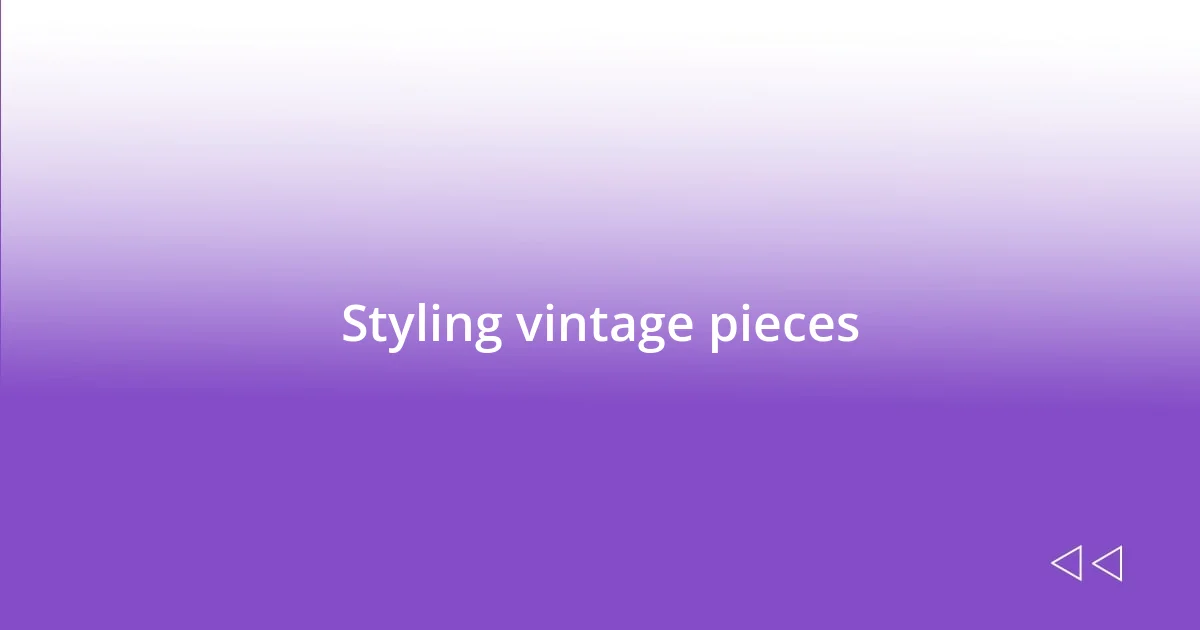
Styling vintage pieces
When it comes to styling vintage pieces, blending them with contemporary wardrobe staples can create delightful contrasts. I vividly remember the first time I paired a flowy, floral 1970s blouse with my favorite skinny jeans. The unexpected combination not only elevated my look but also sparked conversations everywhere I went. Have you ever experimented with mixing old and new styles?
Accessorizing is another way to enhance your vintage finds. I once discovered a stunning retro belt adorned with intricate buckles that turned an ordinary dress into a showstopper. Adding vintage accessories like this can breathe new life into your outfits, making them uniquely yours. What statement pieces do you have that make you feel confident?
Sometimes, the key to styling vintage pieces lies in embracing their quirks. I remember a vibrant 1980s jacket with oversized shoulder pads that I was initially hesitant to wear. After some reflection, I decided to rock it with confidence, and it became a conversation starter at every event! How do you feel when you step out in a bold vintage piece that speaks to your personal style?
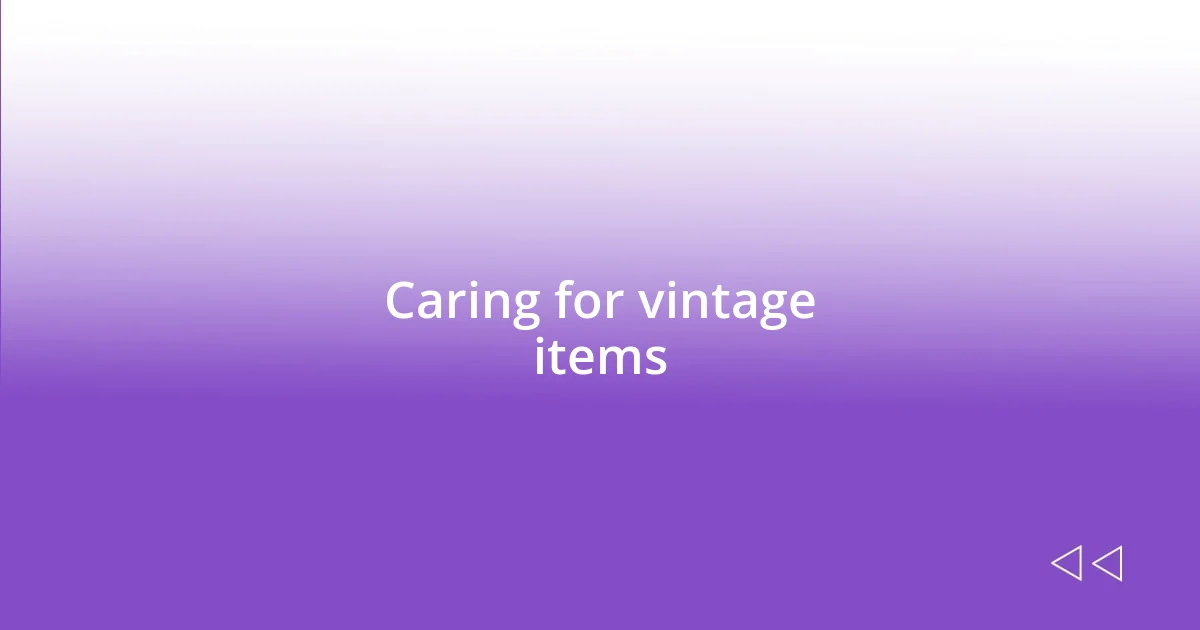
Caring for vintage items
Caring for vintage items is a delicate process that I’ve learned to appreciate over time. One of my favorite pieces is a 1960s silk scarf that I initially tossed in the wash, only to discover later that it had lost some of its vibrant color. Now, I always opt for hand washing with gentle soap and air drying to maintain the fabric’s integrity. What’s your go-to method for preserving your treasured finds?
I’ve also discovered that proper storage is essential for keeping vintage items in tip-top shape. I remember finding a beautiful 1940s dress that had developed creases and lost its shape after being haphazardly stuffed away in a closet. Now, I hang delicate pieces on padded hangers or store them in breathable garment bags to prevent damage. How do you ensure your vintage pieces stay in their best condition?
Lastly, I can’t stress enough the importance of regular inspections. I once neglected a pair of vintage leather boots that I cherished, and over time, they started to show signs of cracking. Now, I examine each item every few months, applying leather conditioner or repairing small wear and tear before it becomes a bigger problem. What routines do you follow to keep your vintage collection looking fresh?

